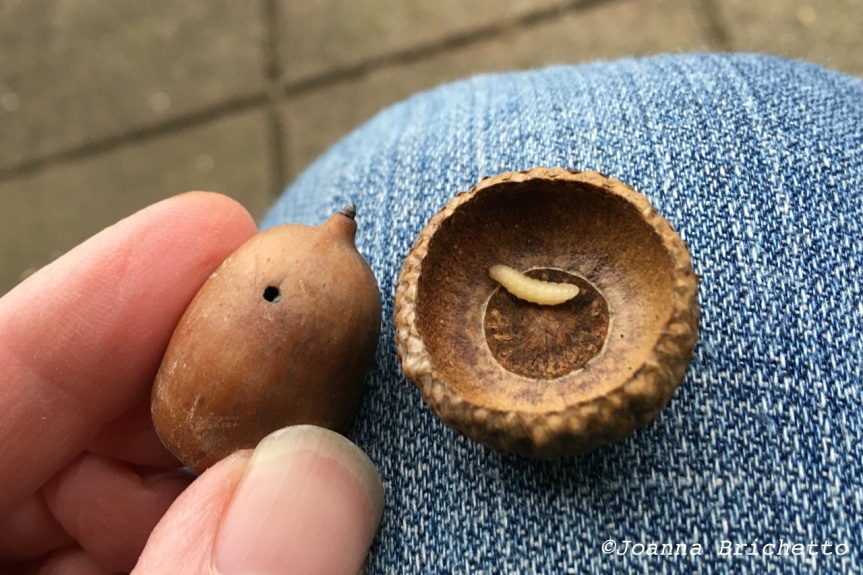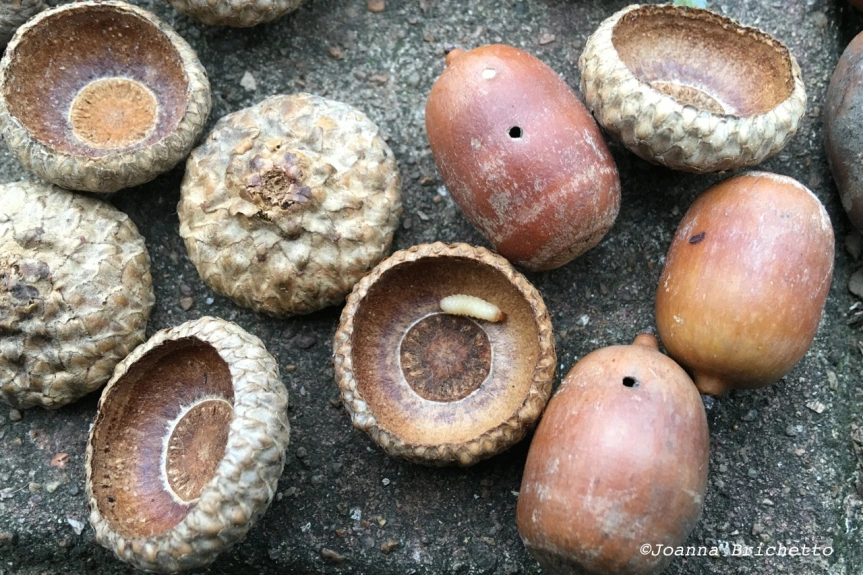
Shumard oak acorns, caps and a former resident.
I don’t have the patience to confirm these acorn cap scales are arranged in a Fibonacci sequence, but there is another marvel in the photo, and it is quicker to spot. See the pinhole in two of the shells? The hole tells squirrels and foragers we need not gather these acorns, because what remains inside is not a meal but a mealy powder. It’s the exit hole of an acorn weevil larva.
We collected these acorns in late November, but I forgot to give them to my acorn-requesting friend till yesterday, by which time a larva had emerged. I wasn’t surprised to see it, but it must have been shocked to tumble into a ziploc bag rather than onto moss and leaves.

Our legless grub developed inside the acorn for weeks. First, mama weevil sawed a hole in the still-green shell with her specialized snout. What does she look like? Imagine Gonzo from The Muppet Movie. Mama snacked on fatty nutmeat, then turned ’round to insert an egg and plug the hole with her own poo. The larva hatches, feasts, and morphs into the adolescent you see here: a helpless blob. This guy can’t even scale the shallow acorn cap. It just undulates toward the rim and tumbles back.
Like Sisyphus, but without the rock, and if Sisyphus was a grain of sushi rice.

The grub knows to chew its way out when the acorn falls, and then it can wriggle underground to complete its metamorphosis. We released our trapped grub in the front yard. Next year, if it makes it to adulthood (with wings and a Gonzo snout) maybe it can fly to the magnificent white oak one street over.

If I were a grub, I’d take the easy way out and find the hole my mom left. At the very least, it could serve as a pilot hole, ready for enlargement. The holes look perfectly round to the unaided eye, but not nearly big enough. Why go to the trouble of eating a hole in your own nursery if you don’t chew it big enough to wiggle out with ease? Compare girth of grub and width of hole. A tight squeeze, even if your body is made of Marshmallow Fluff. It can take a larva three days to squoonch out. That’s three days of exposure surrounded by countless creatures who count grubs as meals.
National Geographic made a short video of a grub extruding itself and it shows quite a struggle. It is also a struggle to watch if a watcher is sensitive to insect imagery and ick-factor. When I showed the video in class one year, a kid had to leave the room.
I didn’t even tell him people use the grubs as fish bait nor did I mention how handfuls of larvae taste “buttery” when fried over low heat. (High heat makes them explode.)
I do not want to fish with or snack upon acorn weevil larvae, but I do think they are marvels. Don’t you?
– – – – – – – – – – –
Practical matters for foragers: How can you know if the fresh acorn in your hand is host to a concealed grub? One crude method is to judge by weight. Like matzah balls, acorns within a species happen in two categories: floaters and sinkers. With matzah balls, both kinds are delicious. With acorns, only the sinkers.
You can also go by bounce: a pristine acorn will bounce when flung at the sidewalk. A mealy one will not.
ID: My guess for genus is Curculio (long-snouted acorn weevil beetle), with perhaps glandium as species. Or maybe Gonzo-ium.

National Geographic video of acorn weevil life cycle.
You are so cool and smart. How can I be more like you? lol
But seriously, I love learning about these critters and all things natural from you. Thanks!
Thanks for reading it, Susu!